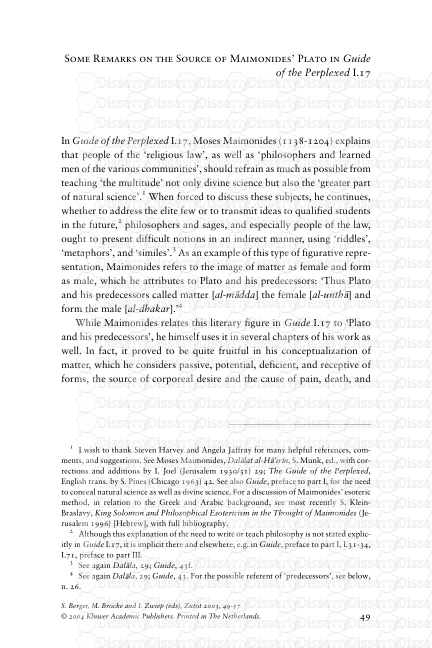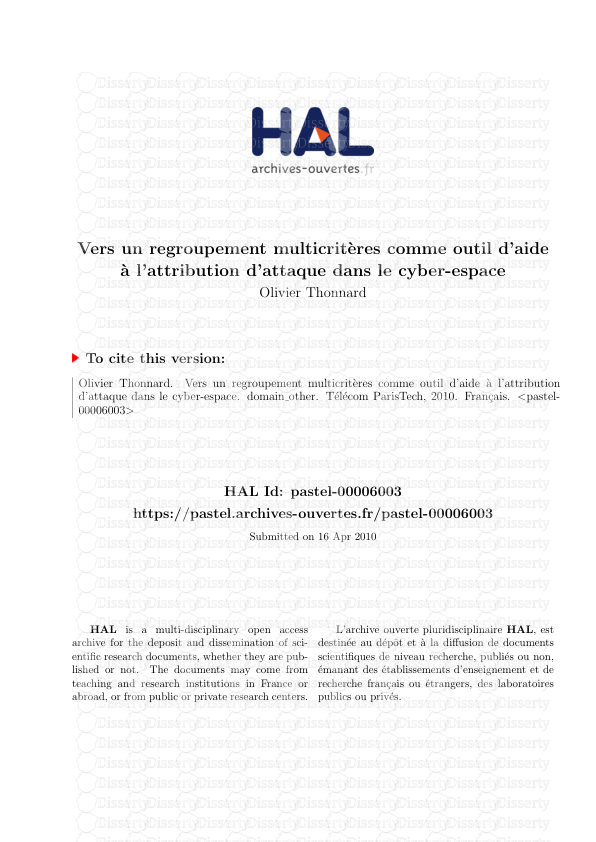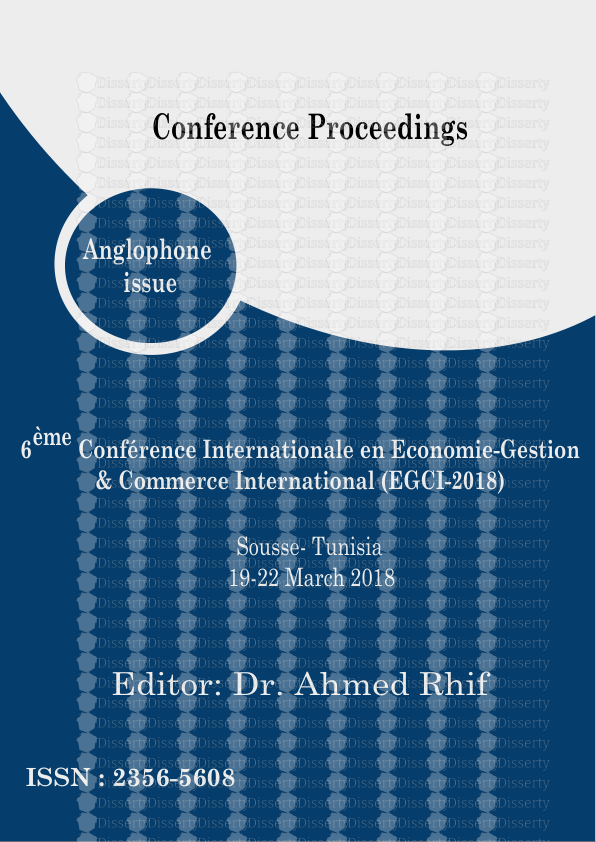Conference Proceedings ISSN : 2356-5608 Anglophone issue 6 Conférence Internati
Conference Proceedings ISSN : 2356-5608 Anglophone issue 6 Conférence Internationale en Economie-Gestion & Commerce International (EGCI-2018) Sousse- Tunisia 19-22 March 2018 ème Editor: Dr. Ahmed Rhif Ahmed Rhif, Tunisie Abdelkader Djeflat, France Abdellah Abil, Maroc Manuela Epure,Roumanie Philippe Desbrières, France Riccardo Beltramo, Italie Abdelatif Kerzabi, Algérie Adil Bami, Maroc Amine Dafir, Maroc Arezki Souak, Algérie Asmaa Echcharqy, Maroc Badia Oulhadj, Maroc Bouchaib Ferrahi, Maroc Bouchra Bennani, Maroc Boutaina Ismaili Idrissi, Maroc Chabani Smain, Algérie Chennoufi Noureddine, Algérie Dominique Ben Cherqui , France Fadma Ait Mous, Maroc Fatima zohra Souak, Algérie Fatim-Zohra Benmoussa, Maroc Abdelati Hakmaoui, Maroc Bouchra Lebzar, Maroc Emmanuel Chéné, France Ibrahim A. Kerkoub, Algérie Houcine Berbou, Maroc Houyem Chekki, Tunisie Kherchi Medjden Hanya, Algérie Hasna Khobzi, Maroc Herizi Ratiba, Algérie Hind Kabaili, Maroc Ibtissam Abarar, Maroc Imen Bennour, Tunisie Kamel Merdaour, Algérie Kamila Ghidouche , Algérie Latifa Fahssis, Maroc Manal El Abboubi, Maroc Mohamed A Balambo, Maroc Mohamed Benbouziane, Algérie Mohammed Aarab , Maroc Mustapha Bachiri, Maroc Anissa Louzir, Tunisie Boutaina Ismaili Idrissi, Maroc Deniz Akagul, France Dominique Bessières, France Hassiba Djemaa, Algérie Kirsten Bourkhardt, France Lamia Azouaou, Algérie Ouardia Laoudj, Algérie Rosalie Douyon , France Sam Guedouard, Australie Sanaa AIT DAOUD, France Nabil Jedlane, Maroc Nour Mohammed Rida, Maroc Rania Mahtaj, Maroc Rihab Abba, Maroc Safae Aissaoui, Maroc Sara Sbai, Maroc Soheir Amri, Maroc Yonca Deniz K.Gurol, Turque Younes Ettahri, Maroc Zouhair Sofiani, Maroc Conference Board General chair Summary Regional analysis of financial barriers to innovation: A multilevel approach Page 5 Challenges and Barriers of Women’s Entrepreneurship Experience from Morocco Page 10 Evolution of asset evaluation methods and convergence to IFRS: case of Algeria Page 19 Improving health coverage systems through simulation Page 27 TOPSIS-based OptQuest for strategy selection in Tunisian social security establishment Page 32 Convergence to IFRS: Reliability and usefulness of accounting information. Case of Algeria Page 36 The impact of human factors on the trade-off behaviour between common transport and the private car- the case study of Algiers Page 44 Multilayer perceptron (MLP) and radial basis function network for the prediction of the Tunisian small and medium enterprises’ (SME) bankruptcy Page 53 Integrate subcontracting into Supply chain configuration and diffusion of new Product Page 67 Heuristic for the Mixed Team Orienteering problem with capacity constraints Page 71 Approach of Principal component analysis for the modal choice problem Page 75 Simulation based optimization models to allocate personnel and reduce the expected waiting time in an outpatient medical service Page 80 Regional planning and territorial development in morocco Page 89 Adoption et usage des Smartphones à Casablanca: quel impact sur le projet Casa Smart-city Page 94 Regional analysis of financial barriers to innovation: A multilevel approach Mouna Khiari#1, Jaleleddine ben Rejeb*2 # Doctor in economics, LAMIDED, ISG Sousse, University of Sousse, Tunisia 1 mouna_khiari@yahoo.fr * Professor of Quantitative Methods, Director of Economic & Technical Dept, Arab Monetary Fund, Abu Dhabi 2 Jaleleddine.benrejeb@esct.rnu.tn Abstract— This article aims to highlight, using a multilevel model, the effect of the region on financial barriers to innovation in Tunisian firms. To do this, we used data on a sample of 620 firms observed by the Ministry of Higher Education and Scientific Research in 2008 covering 24 governorates. The results indicate that the impact of financial barriers on the innovation activities in Tunisian firms differs from one governorate to another. This dispersion is partly due to the economic particularity of each region and the specific nature of regional infrastructure in Tunisia. Keywords— Innovation, financial barriers, region, multilevel model, Tunisia, firms. INTRODUCTION The identification’s approach of barriers to innovation is much more recent than that addresses the determinants of innovation [10]. The authors identify different types of obstacles in firms in order to know their nature, origin, importance and also their impact on the innovation process. This aims to measure the effects and consequences of these barriers on the innovation activities, which is not easy [1]. This approach also allows evaluating the effectiveness of public actions and identifying corrective measures to overcome or eliminate these obstacles. Barriers to innovation are of different nature, and they can play a key role in defining characteristics of the external technological environment. They also influence in determining the attractiveness of a region for multinational and local companies. The decision to locate firms in specific areas and commit oneself in innovative activities could be affected by the assessment of the difficulties that will be encountered in the innovation process. The main purpose of this paper is to show how the geography of innovation can benefit from the multilevel modeling. We provide a formal evaluation of the hypothesis that the geographical location of the company influences the probability of that to innovate and this, by facilitating access to resources or slowing and stopping its innovative activities. The paper is organized as follows. Section 1 presents the literature review. Section 2 investigates the importance of financing innovation in Tunisian firms. In Section 3 we provide modelling and data and state empirical results. Finally, the last section concludes the paper and discusses policy implications. I. LITERATURE REVIEW There is no doubt that innovation is a necessary key to improve productivity, growth and sustainability of the firm. Given this environment, knowing the factors that raise innovation is the solution. This study identifies and point out the disparities of financial barriers to innovation perceived and experienced by Tunisian companies. According to [15] innovation is something new. It’s about creating something new through the processes of learning or knowledge. [5] found that innovation is widely recognized as a key factor in the competitiveness of nations and firms. Smaller companies that do not adopt innovation in their growth strategies run the risk of losing competitiveness because of their obsolete products and processes. The study of innovation and firm’s innovation attitude is relevant in this context given that innovation is becoming, increasingly, a critical factor for the sustainability and survival of firms. Moreover, it becomes even more important to target the causes that prevent companies realizing innovative activities. [2] stated that there are factors or obstacles that inhibit innovation. These factors, which place the obstruction or inertia in innovation, qualified as barriers to innovation, can occur for various reasons. The identification and categorization of these barriers are essential seeing that this will allow us to create mechanisms to reduce their existence, minimize, remove or convert them into facilitators of innovation. Copyright IPCO-2018 ISSN 2356-5608 Page 5 6ème Conférence Internationale en Economie-Gestion & Commerce International (EGCI-2018) For most authors, they divide these obstacles into internal and external obstacles ([6], [2], [5], [24]). Internal barriers are those that occur within the firm and external barriers are those from the external environment of the company. [6] describes the lack of government support as an important barrier to innovation in the European country. [4] revealed two barriers to innovation in a study conducted in five Portuguese SMEs. These obstacles are the lack of qualified human resources or skills and a huge lack of external communication between knowledge generators (universities and investigation institutes). In France, as shown by [10], the Community Innovation Survey highlighted new obstacles to innovation that the major obstacle is the high cost of innovation followed by the lack of appropriate financial sources. A general analysis of the work that address obstacles to innovation, shows a real lack of studies that focus on developing countries, especially in Arab and Muslim countries. II. FINANCING INNOVATION The innovation policy is unfortunately not rooted in many firms in Tunisia because of the lack of strategies and traditions. However, Tunisian companies can provide a concrete example of successful innovation activities, never the less technological, financial and trade gaps remain, and innovation continues to be overlooked in many firms. Unfortunately, many companies do not have the necessary, human and material, resources to adopt an innovation policy that will bring joy to creeping companies. This has led many entrepreneurs who believe in the local market and refuse all foreign competition, to constantly undergo competitive attacks, especially as they tend to react too late to new events in the local market. The technological and commercial breakthrough cannot be achieved without a research and development (R & D) policy. The technological future of any country depends on its level of spending in this area. The more a country is rich, the more it invests in R & D activities. In recent years we saw that financing innovation is over taken the R & D spending. This is due to the support of capital venture that has become a source of finance to innovation. When it comes to meeting the financing needs of innovations, innovative companies face many challenges. The risk for investors is very high, and funding is therefore very difficult to obtain. Funding sources generally come from business angels and personal funds of entrepreneurs and their families. The banks, for their part, are rarely active for small companies. Indeed, bankers are based primarily on the company's historical accounting, on repayment capacity and the guarantees offered. When companies reported financial barriers to launch an innovative project, uploads/Science et Technologie/ conference-proceedings-egci-x27-2018-anglophone-issue.pdf
Documents similaires










-
85
-
0
-
0
Licence et utilisation
Gratuit pour un usage personnel Attribution requise- Détails
- Publié le Sep 13, 2021
- Catégorie Science & technolo...
- Langue French
- Taille du fichier 2.9364MB


